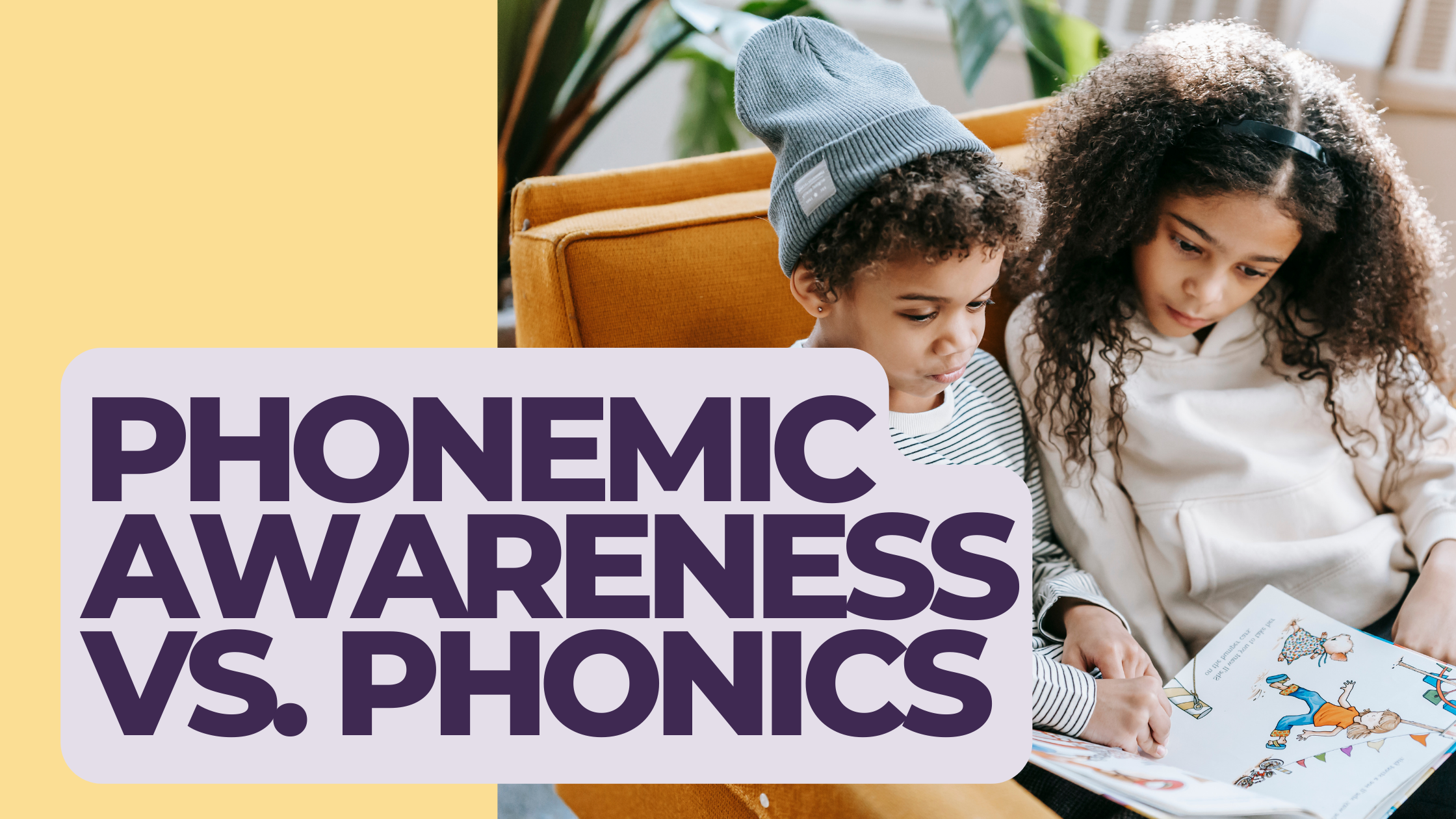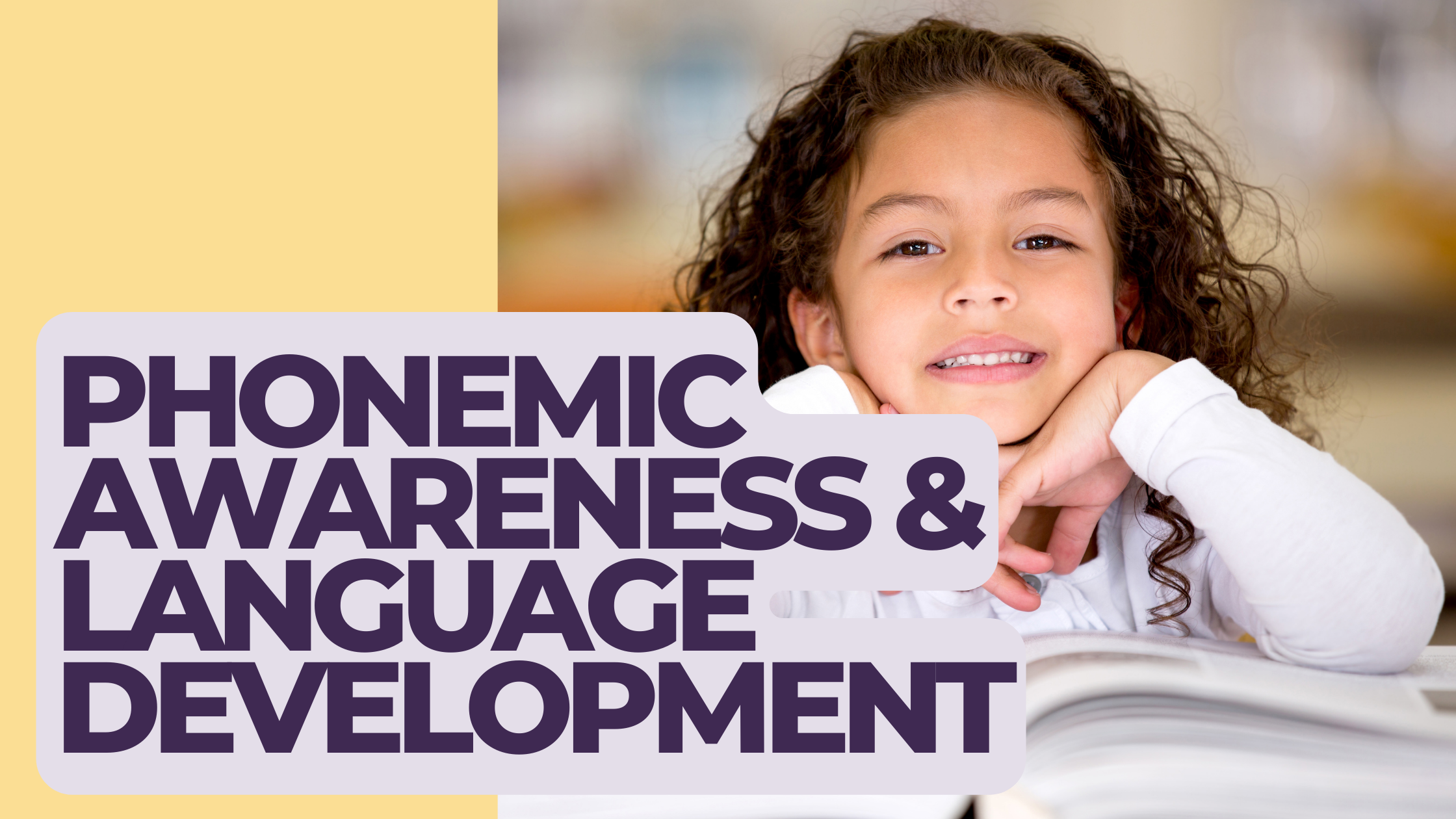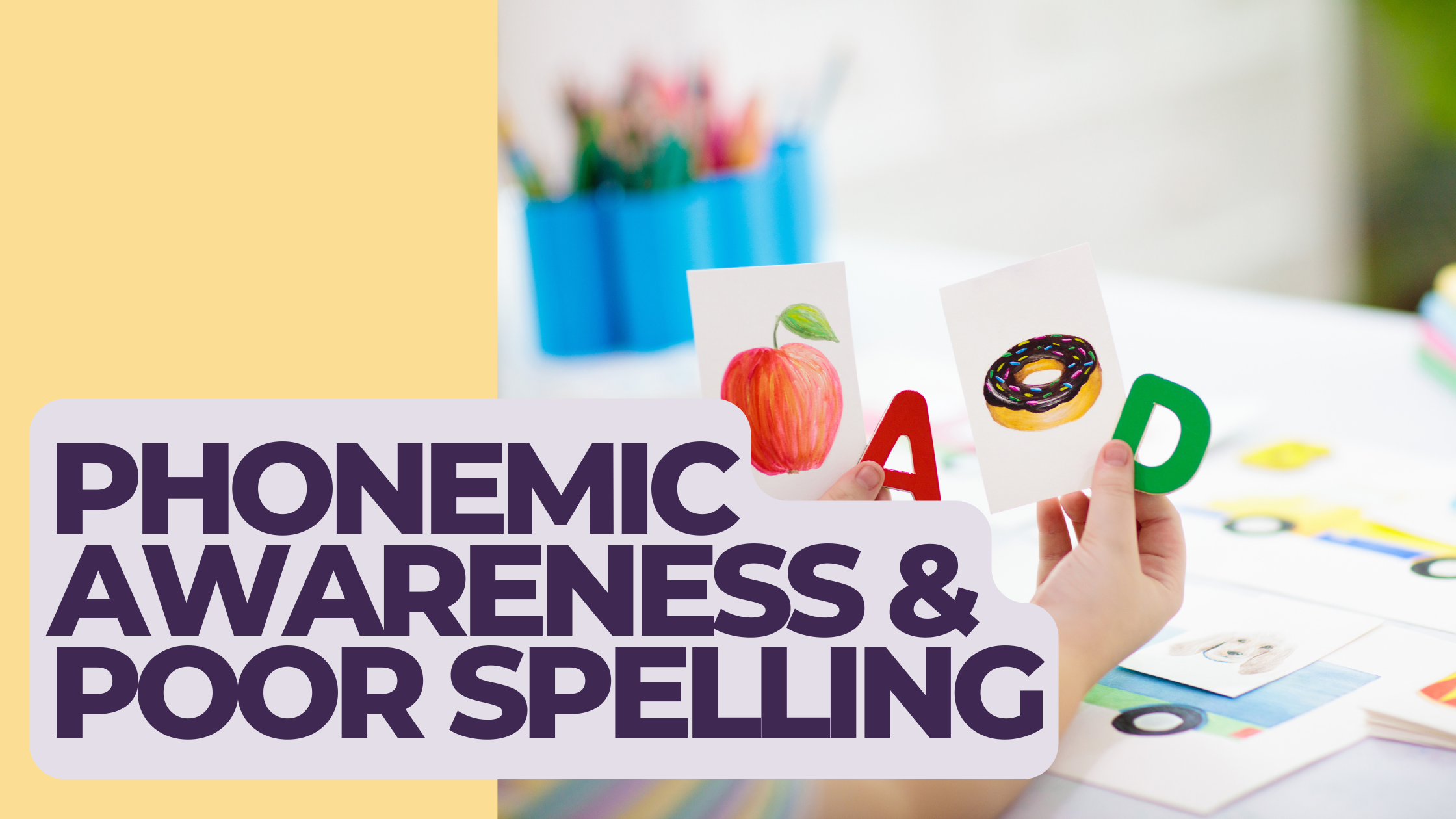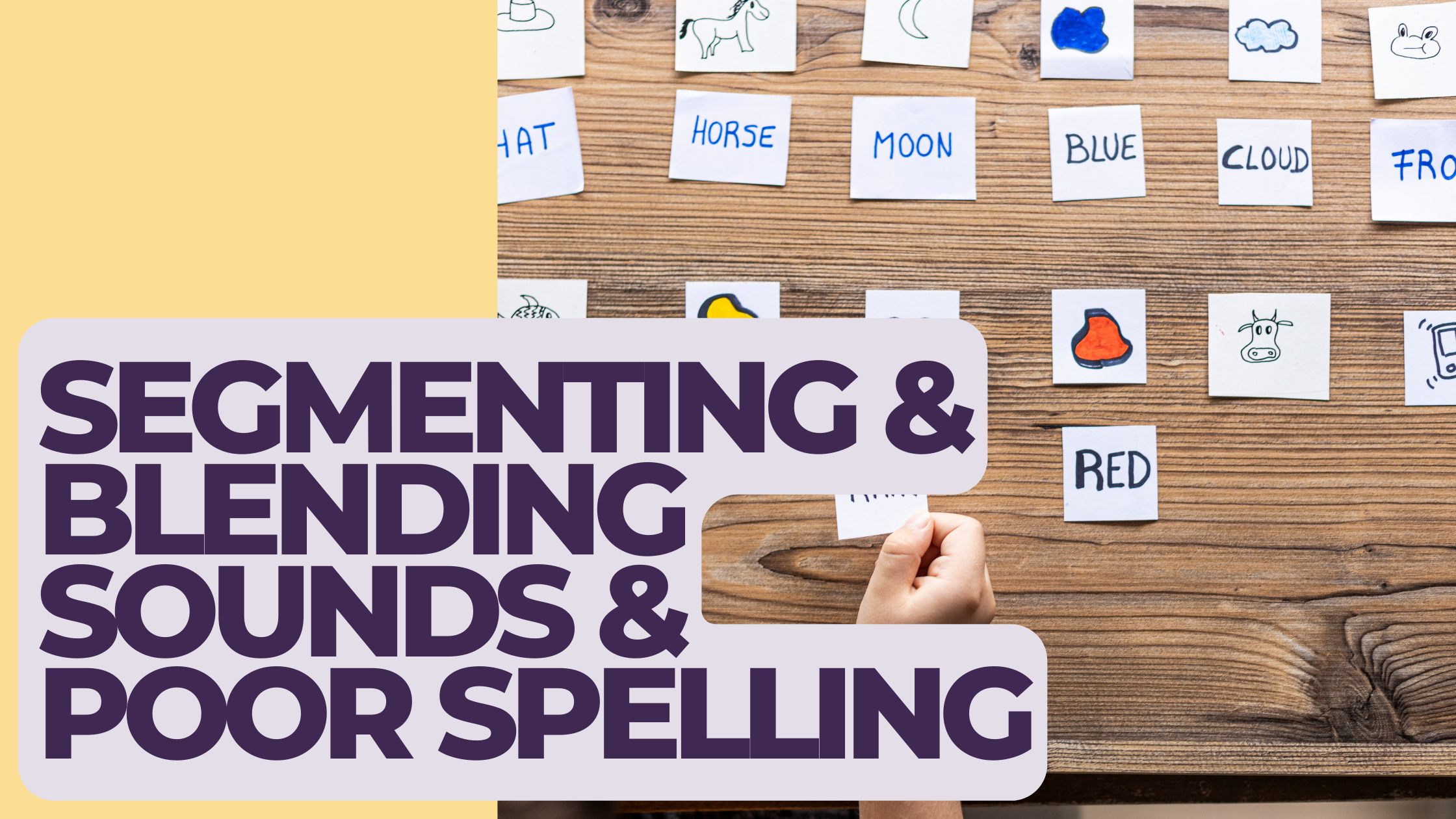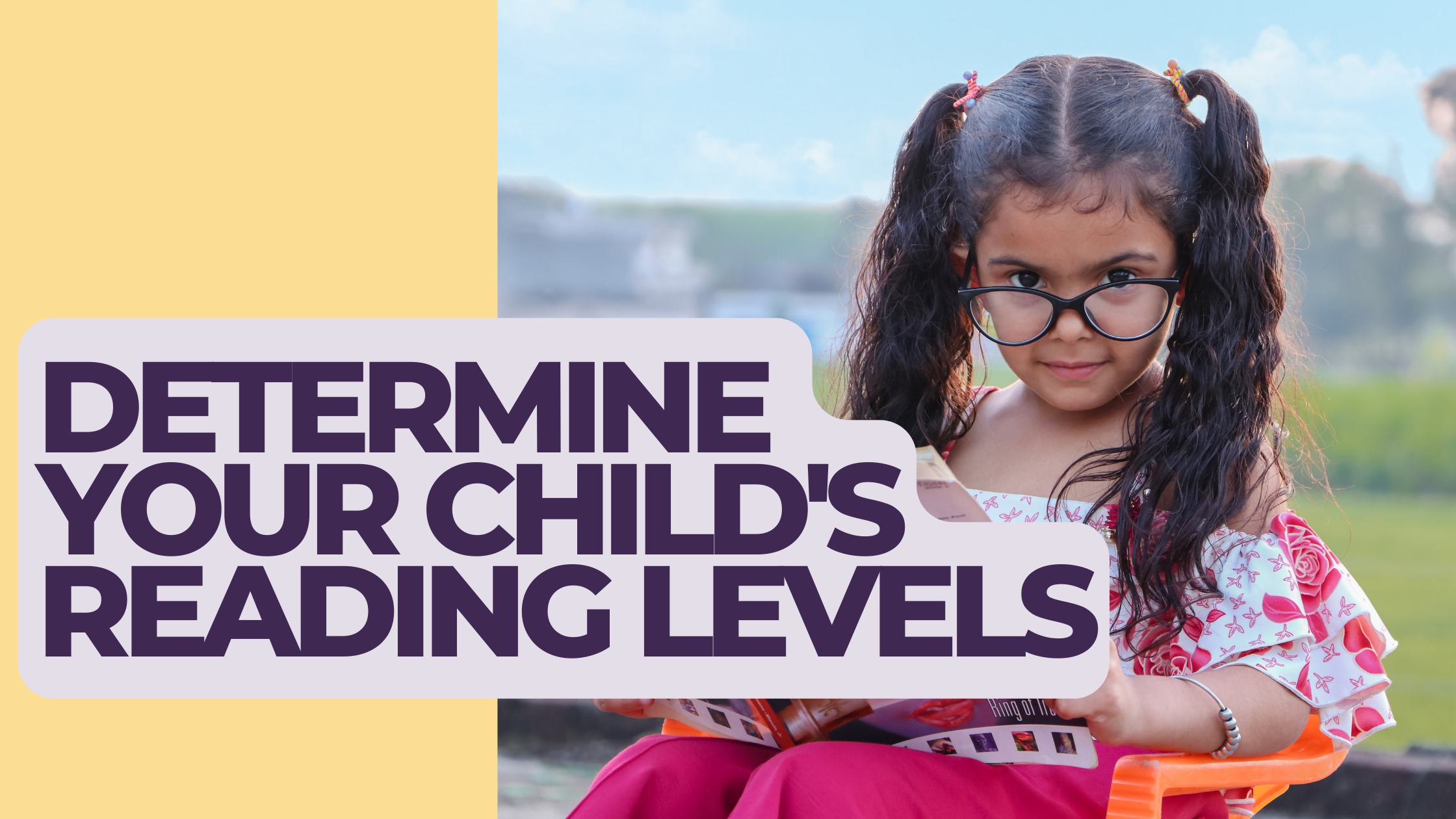BLOG
Learn what’s really holding your child back—and how to move forward with clear, research-based reading strategies you can start using today.
Understanding the Differences Between Phonemic Awareness and Phonics in Reading Development
When it comes to teaching children how to read, two terms often come up: phonemic awareness and phonics. Though they may sound similar and are both essential components of reading development, they are not the same thing. First of all, phonemic awareness is what happens in the dark. In other words, it is all oral. The child can hear the sounds. In phonics, we are dealing with the print. This blog post will examine the differences between phonemic awareness and phonics, and how each contributes to a child's ability to read.
Phonemic Awareness: The Building Blocks of Reading
Phonemic awareness is the ability to recognize and manipulate the individual speech sounds, called phonemes, in spoken words. It involves hearing and understanding that words are made up of different sounds, and that changing these sounds can create new words. For example, a child with phonemic awareness can identify that the word "bat" has three sounds, /b/, /a/, and /t/. They can also understand that by changing the first sound to /c/, a new word, "cat," is formed.
Phonemic awareness is considered a foundational skill for reading because it helps children understand that letters and words represent sounds. This awareness helps them make the connection between spoken and written language, which is crucial for learning how to read.
Phonics: Decoding the Written Language
Phonics, on the other hand, is teaching children the correspondence between letters (graphemes) and their respective sounds (phonemes). This helps them decode, or "sound out," written words. Phonics instruction teaches children the different sounds that letters can make, as well as how to blend those sounds together to form words.
While phonemic awareness focuses on the sounds of spoken language, phonics instruction deals with the written representation of those sounds. Through phonics, children learn to match the sounds they hear with the letters they see, allowing them to decode new words and improve their reading ability.
The Relationship Between Phonemic Awareness and Phonics
Phonemic awareness and phonics are closely related but distinct skills in reading development. Phonemic awareness lays the groundwork for phonics by helping children understand that words are made up of individual sounds. Once they have developed this understanding, they can move on to learning how those sounds correspond to letters through phonics instruction.
It's important to note that while phonemic awareness is a necessary precursor to phonics, it does not guarantee that a child will automatically grasp phonics concepts. Phonemic awareness and phonics must be taught to ensure a child's reading success.
In summary, phonemic awareness and phonics are essential components of reading development that work together to help children become proficient readers. Phonemic awareness focuses on the ability to recognize and manipulate the sounds in spoken language, while phonics teaches children how to decode written words by connecting letters to their corresponding sounds. By understanding the differences between these two concepts and how they relate, educators and parents can provide a solid foundation for children's reading skills. If you see that phonics alone is not helping your child blend sounds, sign up for a free online reading assessment to discover what is causing a weak foundation for your child.
Phonemic Awareness: A Key Component in Language Development
Phonemic awareness is a foundational skill that is critical in developing a child's ability to read and write. It refers to the understanding that spoken words are made up of individual sounds, called phonemes, which can be manipulated and combined to create new words. In this educational blog post, we will delve into the importance of phonemic awareness and how it can be nurtured in the early stages of a child's life.
The Building Blocks of Phonemic Awareness
Phonemic awareness is a subcategory of phonological awareness, which encompasses a broader range of skills, such as recognizing and manipulating larger units of sound like syllables and rhymes. Developing phonemic awareness enables children to identify, isolate, and manipulate the individual sounds that makeup words, ultimately paving the way for successful reading and spelling.
For example, a child with phonemic awareness can recognize that the word "cat" is composed of three distinct sounds: /k/, /æ/, and /t/. They can also understand that by changing the first sound to /b/, they create a new word – "bat."
The Role of Phonemic Awareness in Language Development
Research has consistently shown that phonemic awareness is a crucial predictor of reading success. Children with strong phonemic awareness skills have an easier time learning to read and are likelier to become proficient readers and better spellers than those who struggle with this skill.
Phonemic awareness provides the foundation for understanding the alphabetic principle – the idea that letters represent sounds, and these sounds can be combined to form words. By developing phonemic awareness, children can better grasp the concept of how letters correspond to sounds and how those sounds combine to create words. This understanding is essential for decoding (reading) and encoding (spelling) written language.
Fostering Phonemic Awareness in Children
Phonemic awareness can be nurtured through various activities that promote active engagement with sounds in spoken language. Here are some suggestions for fostering phonemic awareness in young learners:
Read aloud:
Regularly reading to children exposes them to the sounds and patterns of language, helping to develop their listening and phonemic awareness skills.
Rhyme and repetition:
Introduce children to nursery rhymes, songs, and poems that feature repetitive sounds and patterns. This will help them recognize and manipulate the sounds within words.
Sound games:
Encourage children to play games that involve listening to and identifying specific sounds. For example, ask them to find objects that start with a particular sound or have them clap for each sound they hear in a word.
Elkonin boxes:
Use Elkonin boxes (also known as sound boxes) to help children segment words into individual sounds. Draw a series of boxes on a piece of paper, with one box for each sound in a word. Then, have the child move a small object (like a marble or a chip) into a box for each sound they hear when they say the word.
Sound manipulation:
Challenge children to create new words by changing, adding, or removing sounds within words. For example, ask them to change the first sound of "cat" to create a new word.
Conclusion
Phonemic awareness is essential to language development, providing the foundation for reading and writing skills. Parents and educators can help children build a strong foundation for future literacy success by incorporating phonemic awareness activities into daily routines and playtime. So, let's embrace the power of phonemic awareness and unlock the doors to a world of language and learning for our young ones. I can help your child lay a strong foundation for reading and writing. Schedule a free online reading assessment today!
Unraveling the Link Between Weak Phonemic Awareness and Poor Spelling
Have you ever wondered why some people struggle with spelling, while others seem to be born with an innate ability to put pen to paper and craft perfectly spelled sentences? The answer could lie in something called phonemic awareness. In this educational blog post, we will explore the connection between phonemic awareness, phonological awareness, and spelling, and discuss the implications for those with weak phonemic awareness.
What is Phonemic Awareness?
Phonemic awareness is a crucial building block of literacy. It refers to a person's ability to recognize, identify, and manipulate individual sounds (phonemes) in spoken words. In simpler terms, it's the skill that enables us to break down, blend, and rearrange the individual sounds within words to create new ones, like turning the word "cat" into "bat" by swapping out the first sound.
Phonological Awareness vs. Phonemic Awareness
It's worth noting that phonemic awareness is just one aspect of the broader concept of phonological awareness. Phonological awareness refers to a person's understanding of the different sound structures within words, including syllables, rhymes, and phonemes. While phonemic awareness is a more specific skill that focuses solely on individual sounds, both phonological and phonemic awareness are critical for successful reading and spelling.
How Does Weak Phonemic Awareness Affect Spelling?
Research has consistently shown a strong correlation between phonemic awareness and spelling ability. In fact, weak phonemic awareness is considered one of the primary causes of poor spelling. But why is this the case?
Difficulty Segmenting and Blending Sounds
People with weak phonemic awareness often struggle to segment (break apart) and blend (put together) individual sounds within words. This hinders their ability to match sounds with their corresponding written symbols (letters), which is the foundation of spelling. For example, someone with weak phonemic awareness may struggle to identify that the word "dog" is made up of three individual sounds - /d/, /o/, and /g/.
Mispronunciation of Words
Weak phonemic awareness can also result in the mispronunciation of words, which directly impacts a person's spelling. If someone pronounces a word incorrectly, they will likely spell it based on this incorrect pronunciation. This is especially problematic for English, which has numerous irregularly spelled words and homophones (words that sound the same but have different meanings and spellings).
Insufficient Vocabulary and Language Exposure
Finally, weak phonemic awareness can result from limited exposure to language and vocabulary. This is particularly true for second-language learners, who may have less experience with the specific phonemic patterns of their new language.
What Can Be Done to Improve Phonemic Awareness and Spelling?
Targeted Phonemic Awareness Instruction
Research has shown that targeted phonemic awareness instruction, particularly in the early years of schooling, can significantly improve spelling and overall literacy. Activities such as sound matching, sound isolation, and sound manipulation can help to develop and strengthen these crucial skills.
Multisensory Teaching Methods
Incorporating multisensory teaching methods, such as using visual aids, auditory cues, and tactile experiences, can help to engage learners with weak phonemic awareness and reinforce the connection between sounds and their written symbols.
Encouraging Reading and Language Exposure
Lastly, encouraging reading and exposing children to a rich and diverse variety of languages can help to build their phonemic awareness skills and vocabulary. Reading aloud to children, engaging in conversation, and introducing new words are all effective strategies for promoting language development.
Conclusion
In conclusion, weak phonemic awareness is a significant factor that contributes to poor spelling. By understanding the role that phonemic awareness plays in literacy development, educators and parents can implement targeted strategies to support the development of these critical skills and, in turn, improve the spelling abilities of those who struggle. Schedule a free online reading assessment if you suspect that your child’s poor spelling might be linked to a weak phonemic awareness.
How Difficulty Segmenting and Blending Sounds Leads to Poor Spelling
Have you ever wondered why some people struggle with spelling? One of the primary reasons behind this challenge is the difficulty in segmenting and blending sounds. As an essential aspect of phonemic awareness, understanding the relationship between sounds and written words plays a crucial role in spelling proficiency. In this educational blog post, we will delve into the connection between phonemic awareness and spelling, and offer some practical strategies to help overcome these difficulties.
The Link Between Phonemic Awareness and Spelling
Phonemic awareness refers to an individual's ability to recognize, segment, and manipulate the individual sounds or phonemes in spoken words. This skill is vital in developing reading and spelling abilities, as it helps learners understand the relationship between sounds and their corresponding written symbols (letters).
Without strong phonemic awareness, individuals may find it challenging to segment words into their component sounds and blend these sounds to form words. Consequently, their spelling may suffer, as they struggle to match the correct letters to the sounds in their mind.
For example, consider the word "elephant." A person with strong phonemic awareness can effortlessly segment the word into its constituent sounds (e / l / e / f / a / n / t), which enables them to spell the word correctly or close to correct. However, someone with weak phonemic awareness might struggle to identify the individual sounds and their order, resulting in incorrect spelling.
Strategies to Improve Phonemic Awareness and Spelling
Practice Segmenting and Blending Sounds
Encourage learners to break down words into their component sounds and then blend them back together. This exercise can be done orally or using letter tiles or cards. With consistent practice, students will become more adept at segmenting and blending sounds, improving their overall spelling abilities.
Engage in Wordplay
Rhyming games, alliteration activities, and tongue twisters can help learners develop a better awareness of the distinct sounds in words. Wordplay activities can be both fun and educational, fostering a positive attitude toward learning.
Utilize Multisensory Techniques
Incorporate visual, auditory, and kinesthetic elements into spelling instruction. This approach caters to different learning styles and helps to reinforce the connection between sounds and written symbols. For instance, learners can trace letters in sand or use sign language while reciting the sounds.
Teach Phonics Systematically
Provide learners with explicit, systematic phonics instruction to establish a strong foundation in the sound-symbol relationship. By learning the rules and patterns of phonics, students develop a better understanding of how to segment and blend sounds, ultimately improving their spelling.(my bio)
Provide Ample Opportunities for Practice and Feedback
Offer learners ample opportunities to practice their spelling skills and provide immediate, constructive feedback. This process will help them in recognizing their mistakes and making necessary adjustments, leading to steady improvement in their spelling abilities.
Conclusion
In conclusion, difficulty segmenting and blending sounds can significantly contribute to poor spelling abilities. By understanding the importance of phonemic awareness and employing targeted strategies, learners can overcome these challenges and develop strong spelling skills. As educators and parents, it is our responsibility to provide the necessary support and guidance to help our children excel in this critical aspect of language development. I can help you set language development goals. Schedule a free online reading assessment today.
The Benefits of Online Reading Tutoring: A Comprehensive Comparison with In-Person Instruction
In today's fast-paced and technology-driven world, education has adapted to the changing times and expanded its horizons to include online learning. One such field that has seen significant growth is online reading tutoring. With numerous advantages over in-person instruction, online reading tutoring has become a popular choice for many parents and students. In this educational blog post, we will explore the benefits of online reading tutoring and compare it with in-person instruction, highlighting the reasons why it stands out as the better alternative.
Flexible Scheduling
One of the key benefits of online reading tutoring is the flexibility it offers. Students can access their sessions from the comfort of their homes at any time that suits their schedules. This flexibility also extends to the tutors, who can be available for sessions outside of regular school hours. In comparison, in-person tutoring often requires transportation and adherence to fixed schedules, which can be challenging for both the student and the tutor.
Personalized Learning
Online reading tutoring allows tutors to tailor their lessons and materials to suit the individual needs of each student. They can quickly adapt and modify their teaching style to accommodate different learning styles and preferences. This personalized approach helps students to better understand and grasp the concepts being taught. In contrast, in-person tutoring can sometimes be limited in its adaptability and customization due to time constraints and the availability of resources.
Access to a Wider Pool of Tutors
With online reading tutoring, students and parents have the opportunity to choose from a vast pool of experienced and qualified tutors from all over the world. This means that they can find the perfect tutor who specializes in their specific learning needs and objectives. In-person tutoring, on the other hand, may limit the potential tutors to those available within the immediate geographical area.
Consistent Progress Monitoring
Online reading tutoring platforms usually come with integrated tools and software that enable tutors to monitor and track the progress of their students effectively. This allows tutors to identify any areas of weakness, and they can adjust their teaching strategies accordingly. With in-person tutoring, progress monitoring may not be as consistent or accurate, as it often relies on manual assessments and evaluations.
Cost-Effectiveness
Online reading tutoring eliminates the need for transportation, printed materials, and other potential expenses associated with in-person tutoring. As a result, the overall cost of online tutoring tends to be significantly lower than in-person options. This makes it a more affordable option for many families looking to invest in their children's education.
Conclusion
In summary, online reading tutoring offers numerous benefits over in-person instruction, including flexible scheduling, personalized learning, access to a wide pool of tutors, consistent progress monitoring, and cost-effectiveness. As technology continues to advance, the gap between online and in-person instruction is rapidly closing, with online reading tutoring emerging as a powerful and effective alternative. For a student's educational success, parents should consider the advantages of online reading tutoring and make the choice that best suits the needs of their children. If you want to give online reading tutoring a try, schedule a free reading assessment.
Nonfiction Reading Comprehension
We assume our child will understand a fiction story because the book is at their reading level; however, reading is more than decoding. Yes, I know, you have worked so hard to make sure your child can read and now, I tell you that decoding does not guarantee reading comprehension of fiction. How can this be? Let me elaborate: lack of comprehension is not solely a decoding problem. Reading comprehension is more than sounding out letters and blending sounds. Every time your child opens a fiction book, they might be finding themselves ill-prepared to read fiction with comprehension. This lack of reading comprehension can be a result of limited background knowledge on the topic because of limited life experiences and/or limited non-fiction reading.
Reading at grade level does not equal reading comprehension when reading fiction.
We assume our child will understand a fiction story because the book is at their reading level; however, reading is more than decoding.
Yes, I know, you have worked so hard to make sure your child can read and now, I tell you that decoding does not guarantee reading comprehension of fiction.
How can this be? Let me elaborate: lack of comprehension is not solely a decoding problem.
Reading comprehension is more than sounding out letters and blending sounds. Every time your child opens a fiction book, they might be finding themselves ill-prepared to read fiction with comprehension.
This lack of reading comprehension can be a result of limited background knowledge on the topic because of limited life experiences and/or limited non-fiction reading.
Limited Life Experiences
How are we to provide life experiences when we, as parents, have limited resources, time, and namely, money. I am here to suggest that your child’s exposure to a specific reading genre, non-fiction, can equally grow your child’s background knowledge, even if their life experiences are limited. Yes, put your passport away and breathe a sigh of relief.
Non-fiction Enhances the Reading Comprehension of Fiction
Research has shown that background knowledge is essential to the comprehension of fiction. When embarking on the reading of a fiction book, your child will confront situations outside of their geography, time period, culture, and imagination.
Hence, nonfiction can bridge the gap for your child who might have limited experiences and who brings limited prior knowledge to their fiction reading.
Your child will confront narratives that are foreign to them; however, when a child comes with a big repertoire of non-fiction reading, they can imagine, envision, and contemplate the world that the fiction writer is attempting to create.
This accumulation of non-fiction reading gives your child a mental library that they can access and apply to the new worlds created by fiction writers; yes, even worlds that are imaginary.
The reading of non-fiction will not only provide mental flexibility for your child, but will bridge disparities in experiences.
Read More Non-fiction and Comprehend Fiction Better
Anytime your child is introduced to a new text, your child’s interest must be aroused. This can be done by helping them make connections to their prior knowledge from life experiences or the reading of non-fiction.
Through a simple graphic organizer designed by Donna Gogles you can help activate your child’s prior knowledge, so they can make the connection to the fiction they are about to read and will read.
Ask them, “What do you know?”
Activate your child’s knowledge. Have them list what they already know about a topic they will read about in their fiction reading. Make a list.
2. Ask them, “What do you want to learn?”
Consider what gaps your child might have about a certain topic that they will confront in their fiction reading. And give them the opportunity to list what they want to learn about the topic at hand. Choosing what they want to know will motivate them.
3. Ask them, “What did you actually learn?”
Provide non-fiction reading books at their independent reading level, and read aloud those non-fiction books that are above their reading level.
Learn more about your child’s reading levels by signing up for a free online reading assessment.
Have your child read non-fiction at their independent reading level. These are books that they can read at their own. And encourage them to read at their instructional level the books that require some assistance from you.
Finally, you can read aloud those books that they can not read on their own.
After increasing their knowledge through reading or being read to, ask them to tell you what they have learned from their reading. The long list of knowledge they have gained will give them a feeling of accomplishment and will provide a bridge for the fiction topic they will read about.
Again, this simple graphic organizer will help your child feel like they can increase their knowledge through reading. Bringing more background knowledge to the page of a new fiction book will equip your child to comprehend more.
4. Quick activation of prior knowledge can be effective too.
Can non-fiction knowledge be built quickly by reading non-fiction related to fiction? Well, it certainly would not hurt and can be quite effective too.
The reading of non-fiction can be extensive or just enough to prepare your child for the fiction they will be reading.
Again, I always suggest that your child read non-fiction at their independent level. This will facilitate comprehension for your child when reading fiction.
In addition, it will provide quick access to essential ideas that will aid the understanding of a fiction story’s setting, for example.
We certainly can’t provide a lifetime of experiences for our children in their short life span, but we can build their background knowledge as they read or hear non-fiction read to them.
While your child might not be a lover of non-fiction, non-fiction plays a big role in providing background knowledge for their reading of fiction.
Your child may not travel to China and walk the Great Wall of China, but they can bring the mental image they have visualized in their memory as they read about the awe inspiring architecture.
In a parent-tutor partnership, we can work to provide non-fiction reading that will prepare your child for the reading of a fiction book or book series. The familiarity with the subject, often called topical knowledge, will give your child a real connection with the setting of a story, the personality of a character, or the geography of a setting. More importantly, your child’s reading comprehension will increase in both genres: fiction and non-fiction.
Encourage and support the growth of background knowledge in all topics through the reading of non-fiction. As a result, this knowledge will connect the dots in your child’s reading of fiction.
There is no stopping your child: their comprehension of fiction will shoot through the roof with the increase of non-fiction reading.
How to Determine your Child’s Reading Levels
The independent reading level is the reading level at which your child can read without assistance from you or a tutor. At this level, your child is able to read independently and can attain good reading comprehension. It is also an enjoyable read for your child, and their confidence is sky high when reading at this independent reading level.
Question: Is it helpful to know your child’s reading grade level when selecting books?
Answer: Simply knowing your child’s reading grade level is not enough information to make book selections, especially if your child is struggling with reading.
Question: Should you select books that are difficult for your child to read on their own?
Answer: Yes and no. Read on to learn when and how to better expose your child to books that are difficult for them.
As a tutor, I use the QRI6 reading assessment tool. The is a free online reading assessment I administer at the initial consultation.
Below, I list the three reading levels you need to know as a parent, and I detail what each reading level reveals about your child’s reading skills.
The independent reading level is the reading level at which your child can read without assistance from you or a tutor. At this level, your child is able to read independently and can attain good reading comprehension. It is also an enjoyable read for your child, and their confidence is sky high when reading at this independent reading level.
At the instructional reading level, your child can read the book, but will require some instruction from you or a tutor. This means that there might be some phonic patterns that your child has not yet mastered, but they can master them with some guided instruction as they read. Their comprehension is good, and reading books at your child’s instructional reading level will help them move on to the next reading grade level.
The frustration reading level: This is the level at which your child stumbles over every word.
There is no reading enjoyment for your child or for you as a parent when you hear them struggle. As a result of your child’s limited decoding skills, the comprehension is little to none.
Do not frustrate or push your child to read a book that is at their frustration reading level; otherwise, your child will develop a distaste for reading.
Question: How can knowing your child’s different reading levels influence your book selections?
Answer: Often when your child is reading below grade level, you tend to expose them only to simple decodable books for reading. This is not recommended. These decodable books have their role, mainly to provide independent practice for beginning readers. Move your child beyond decodable books.
It is vital that you provide independent level books for your child to read, but you also need to help build a bridge to books that challenge your child’s reading skills. With some instruction from you or a tutor, your child will be able to decode and comprehend what they read. Hence, moving up in reading grade level quicker.
BOOKS AT THE FRUSTRATION READING LEVEL
Reading books above your child’s reading level will frustrate your child if they try to read them on their own. In fact, even guided reading at the frustration reading level will not help your child at this point of their reading development.
If you do force your child to read these books, you will find yourself teaching every other word, if not every word.
Let’s stay away from books that frustrate your child for now; instead, I recommend that you or a tutor read aloud these books to your child.
LISTENING COMPREHENSION
What you might not realize is that while your child may not be able to read at their grade level, they can still listen to stories written above their grade level.
When you have a struggling reader, you need to be proactive and expose them to books of all genres and reading levels. This can be accomplished through read-alouds.
Reading books aloud opens a new world for your struggling reader.
Reading aloud to your child gives them the opportunity to hear the books that their peers are reading and helps them to continue to be part of the bigger conversation.
How will reading books beyond my child’s reading level help my child?
Your child has a higher level of listening comprehension than reading fluency. This means that your child will be frustrated if they read books at their frustration level, but will benefit from hearing these books read aloud to them.
Listed below are skills your child will gain from being read to:
1. Your child will be exposed to vocabulary at their grade level while they catch up on their reading grade level. (This is especially helpful if your child is reading below grade level.)
2. Your child will be able to understand how different types of books are organized and structured.
3. Your child will be exposed to vocabulary at their grade level while they catch up on their reading grade level. (This is especially helpful if your child is reading below grade level.)
4. Your child will be able to understand how different types of books are organized and structured.
5. Your child will get to hear great stories just for the sheer joy.
How do you get your child to listen to a read-aloud above their grade level?
1. Read aloud to your child.
2. Use apps such as Audible that will read stories to your child.
3. Follow youtubers who do read-alouds for children.
How will book selections help my child read at grade level or above?
If you know your child’s independent, instructional, and frustration reading level, you and/or a tutor will be able to guide them in book selections.
Not only will knowing your child’s reading levels help them make better book selections, but you will also be able to raise your child’s current reading level to the desired reading level in a more strategic manner.
If you are seeking help in improving your child’s reading quickly, I am here to help!
The first step is to click here to sign up for a Free Online Reading Assessment
Decode Multisyllabic Words with Prefixes and Suffixes
While your child learned to decode in the earlier grades, there are still obstacles to overcome in the upper elementary grades.
READING TO LEARN
When your child was in kindergarten, first, and second grade, they simply focused on learning how to read.
When they moved to third, fourth and fifth grade they began to read to learn.
Here is where the struggle began for your child. Often your child’s teacher is telling you that your child is scoring low in reading comprehension. This baffles you because in the earlier grades your child was reading just fine.
A NEW DECODING CHALLENGE
While your child learned to decode in the earlier grades, there are still obstacles to overcome in the upper elementary grades.
The biggest obstacle will be multisyllabic words. These are the words with many syllables. These words often contain a base with a prefix and a suffix.
INTIMIDATING WORDS
Multisyllabic words are intimidating to your child.
As a result, your child will take the following steps: try to sound out the words like they did in the earlier elementary years or simply skip the words they can’t decode. Your child will soon discover that simply sounding out the words will prove to be ineffective and laborious when attacking multisyllabic words.
Their inability to decode multisyllabic words will affect their reading speed and fluency, which in turn will prevent them from fully comprehending the text.
Similarly, skipping multisyllabic words will keep them from fully comprehending the text, and they will grow discouraged.
DECODING STRUGGLES
As a parent, we need to keep in mind that reading, specifically decoding, requires a lot of brain engagement.
If your child is struggling with decoding, they can not even begin to focus on comprehension.
Therefore, before you address your child’s reading comprehension struggles, you must equip your child with the necessary tools to tackle multisyllabic words. It might be that once your child can tackle multisyllabic words, their reading comprehension will increase significantly.
RECOGNIZING THE PARTS
There are three key parts your students should recognize in a multisyllabic word: the root word, the prefix, and the suffix.
If your child can recognize these parts of a multisyllabic word, then they can begin to tackle any multisyllabic word they encounter.
Your must learn to quickly recognize each part of a multisyllabic word, pull it apart, and re-assemble it. This will eventually be done in a flash with practice.
OPEN AND CLOSED SYLLABLES IN MULTISYLLABIC WORDS
Learning to recognize open and closed syllables will also make decoding new words easier.
OPEN SYLLABLE
An open syllable has a consonant following a vowel. This causes the vowel to say its short sound.
CLOSED SYLLABLE
A closed syllable has no consonant following a vowel. This causes the vowel to say its name.
If your child knows the difference between an open syllable and a closed syllable, they will be able to tackle any new word.
INTERVENING EARLY
If you equip your child with the ability to decode multisyllabic words, then they can now focus on reading comprehension.
When your child is no longer stumbling over these often large, intimidating words, they can get back to enjoying reading, and their comprehension will increase.
This comprehension will further improve as they learn more reading comprehension strategies too. It is important to intervene early. Reading intervention needs to be done sooner than later. As a parent, you need to be your child’s advocate. Don’t delay in addressing the root of the problem.
THE NEXT STEP
If you want your child to have the necessary tools to become a good reader, I am here to help. Schedule a free online reading assessment.


